In envisioning an integrated Mekong Sub-region (GMS), the governments of the six riparian countries and the Asian Development Bank (ADB) regard the "connecting of nations" as contributing to the "linking of people" and vice-versa.
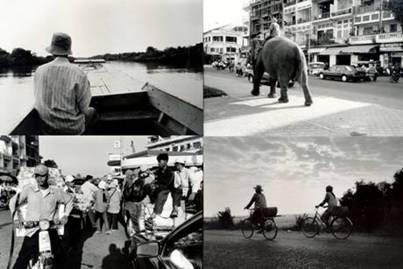
Strategy papers and other programme documents reiterate that the goals of regionalization are not only to enhance "connectivity" and "competitiveness" of the region through the improvement of transportation, telecommunication and power systems, but also to foster a greater "sense of community".
What the creation of a "community" implies for the diverse Mekong is, however, not fully articulated. From these materials, it would seem that the concept refers to enhancing social welfare: by increasing incomes and by preventing disease, degradation of environment, human and drugs trafficking and other social problems, the programme strives to improve quality of life for the inhabitants of the GMS and bring them closer together. Policy documents and policymakers' declarations also hint that collaboration is to foster mutual respect and understanding among diverse groups and countries, and create peace and stability in the region. But then again, not so much is said on how exactly these different processes are to evolve and influence each other in order to realize the vision of a prosperous and peaceful Mekong community.
Recalling the decades-long conflicts that have left indelible marks on the region's people, and the many new tensions emerging over the control and distribution of resources in the region, one may wonder to what extent peoples in the Mekong feel bonded to one another. Many would argue that of the three building blocks of regional integration in the ADB framework, "community" is the one that is lagging behind, as funding and attention has mostly been bestowed on programmes focusing on "connectivity" and "competitiveness". The GMS is gradually becoming an economic and infrastructural entity, but has yet to acquire cultural and social significance for its citizens.
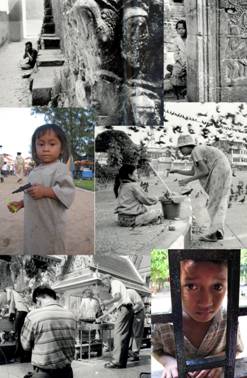
An Integrated, Yet Fragmented Region
Indeed, most peoples of the GMS are not aware of the regional plans affecting their lives. Caught in the specificity of their local contexts, they do not subscribe to the concept of "the Mekong" as a region, remaining divided along socio-economic means and ethnic and national-identity lines.
And, when they do look beyond their borders, as global citizens they are often more interested in what is happening in the United States, Japan and Europe than what is going on in their vicinity. Public knowledge about other Mekong countries remains scant and fraught with stereotypes and biases.
Misunderstandings and prejudices toward neighbors are grounded in biased readings of history. Interviewed by Johanna Son of Inter Press Service Asia-Pacific, the Thai historian and South-east Asia specialist Charnvit Kasetsiri explained that in historical textbooks, Thai children learned many contentious and not always accurate notions concerning other Mekong countries. Referring to the poorly substantiated, yet popular, historical record that the Thai King Naresuan killed the king of Cambodia out of revenge back in 1593, he commented: "The memory easily pops up in many Thais' minds when talking about relations between two. How can we deal with our neighbors peacefully and respectfully and still hold on to such perceptions?"
Persistent tensions also derive from more recent history, such as the Cold War and its aftermath. To this day, Vietnam's historical role in Cambodia is perceived with mixed feelings by part of the Cambodian population who consider the "liberation" from the Khmer Rouge by the Vietnamese Army as abusive "occupation".
Distrust derived from past animosities is compounded by the contemporary resentment provoked by the perceived inequity in the way benefits and costs of regional economic growth are distributed among countries and groups. The control of the Mekong's waters by upstream countries, the skewed use of natural resources, the intrusive expansion of China, the growing gap between wealthier and poorer countries and groups, and the cultural and political domination by more powerful nations and majority groups at the expenses of weaker nations and minority groups are all trends that divide, rather than unite, the GMS peoples.
No wonder, then, that anti-foreign feelings can be exploited relatively easily by politicians and the media to stir up nationalist passions for domestic purposes. The riots that exploded in Cambodia in January 2003 against Thai business interests are one poignant example of how fragile the proclaimed regional unity in the Mekong is. On this, as on other tense occasions, the emphasis in the public discourse quickly shifts from stressing the similarities in customs, traditions and beliefs shared by countries in the region, to exposing their divergent ways of life and unbridgeable contrasts.
The same lack of social cohesion is evident in most populations' attitude toward cross-border migrants. In Thailand, as in neighbouring countries, the public perception of migrants from within the sub-region is generally negative. Age-old prejudices remain deeply ingrained in the public mind, as it became clear in the days following the tsunami in January 2005, when migrants from Myanmar were accused of looting vulnerable households - as their ancestors had allegedly done in the past.
More purposive efforts are needed if an inclusive multi-cultural environment and a sense of community are to emerge in the region. Proclaiming collaboration at the government level or expecting that development efforts that trickle down will eventually foster common ground among the GMS inhabitants are not sufficient. Specific strategies ought to be devised to address xenophobic policies and change everyday perceptions of people across the borders, in order to deconstruct the past, reduce persistent misunderstanding and strengthen the fundamentals for collective bonding.
Overcoming while Respecting Differences
In the conviction that no economic and infrastructural integration can compensate for a dearth in cultural and social unity, a few pioneering efforts - such as collaborative studies on shared histories, networks of GMS journalists, teaching of Mekong studies, and exchanges among GMS students - have been launched. Even if limited in scope, the ideas proposed could break new ground and provide inspiration for larger initiatives.
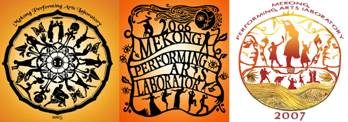
One of these experimental approaches is spearheaded by the PETA Mekong Partnership Project. Since 2004, the Project has strived to build a community of GMS artists committed to enhancing public well-being. Through arts workshops (laboratories) and play production and performances, artists from the six Mekong countries share their experiences and skills and learn to apply their acts to highlight social issues affecting their region, starting with HIV/AIDS and gender discrimination.
From the very beginning - reflecting the regional context - the programme was confronted with the great diversity of cultures, languages, artistic traditions, socio-political visions, and personal opinions. These enriched, but also complicated, the undertaking of this GMS-wide intercultural interaction.
Communicating without a common language often created misunderstanding and confusion among the participants, requiring them to be patient when listening to translations and other facilitation mechanisms. Even if the language of art movement is supposed to be "universal", meanings and gestures vary, and some artists felt frustrated by their inability to communicate their thoughts.
The ways of working also proved to be far from compatible among the diverse national groups, and prejudices abounded about theatre standards in different locations. Discussion on the superiority or inferiority of the respective art forms caused, at times, pejorative judgments of other countries and national ideologies.
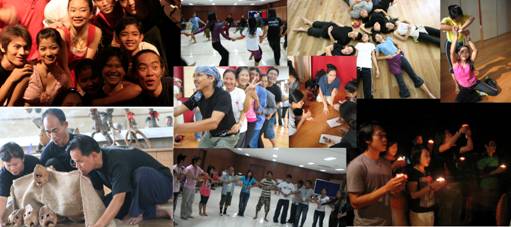
Over the course of time, however, the participating artists came to appreciate the opportunity to learn from one another, explore both traditional and modern art forms, and mix them together in their new productions. Ultimately, they were all struck by the seemingly endless shapes of Mekong arts, many of which they had not known before. They recognized that they had learned to accept each other's differences and respect divergent views. They also felt inspired by their having become part of a larger movement - proud of their art and concerned about their region. Gradually, they came to appreciate that this new awareness and commitment benefited their creativity and enhanced the quality of their productions. In the words of programme coordinator Lea Espallardo, the engaged Mekong artists have shifted from "moving in their own ways to finding a meeting point, and creating new work out of the crossing of paths".
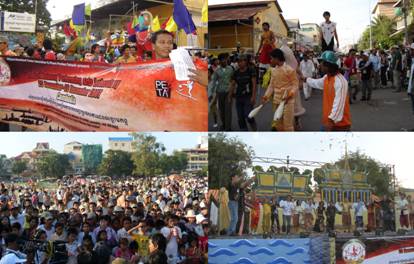
The artists' empowerment could be vividly felt in November 2007, when they showcased the plays they produced in Phnom Penh, on the banks of the mekong River during the Water Festival. A caravan of more that 300 youth and artists opened the third three-week mobile arts laboratory on the way to Siem Reap and Battambang. With it were all kinds of performances expressing the diversity of Mekong arts, united by the joint objective of promoting better health for the populations linked by the ever-nourishing waters of the Mekong. Joining in giving thanks to the river that unites and bestow life to the diverse GMS countries, the caravan and its performances instilled a "sense of community" among the artists and the large crowds that attended the event.
It is to be hoped that this initial spark of concordance will motivate others to take up the challenge of overcoming differences and finding common ground in the pursuit of a shared vision of a pluralistic, yet united, Mekong community.
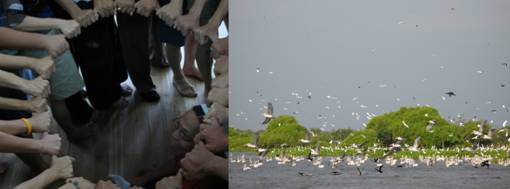
(The author retains sole responsibility for the views expressed.) *Rosalia Sciortino, better known as Lia, is a cultural anthropologist and development sociologist by training who is currently working in Thailand as associate Professor at the Institute for Population and Social Research, Mahidol University, and Visting Professor at the Masters in International Development at Chulalongkorn University. Before that, she was Regional Director of The Rockefeller Foundation Office for South-east Asia in Bangkok, overseeing grant-making activities in the Greater Mekong Sub-region. Previously, she was with the Ford Foundation in Indonesia and the Philippines. She has published widely on development issues. A native of Italy, she has lived in Asia for nearly two decades. ******* The article is provided by Inter Press Service (IPS) Asia-Pacific (http://www.ipsnewsasia.net/ and http://www.newsmekong.org/)
Prachatai English is an independent, non-profit news outlet committed to covering underreported issues in Thailand, especially about democratization and human rights, despite pressure from the authorities. Your support will ensure that we stay a professional media source and be able to meet the challenges and deliver in-depth reporting.
• Simple steps to support Prachatai English
1. Bank transfer to account “โครงการหนังสือพิมพ์อินเทอร์เน็ต ประชาไท” or “Prachatai Online Newspaper” 091-0-21689-4, Krungthai Bank
2. Or, Transfer money via Paypal, to e-mail address: [email protected], please leave a comment on the transaction as “For Prachatai English”
